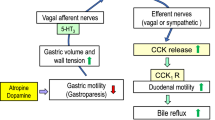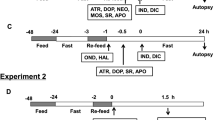Abstract
The present study was performed to examinewhether gastric prokinetic drugs may induce damage inthe rat stomach under normal and prostaglandin(PG)-deficient conditions. Male SD rats fasted for 18 hrwere administered subcutaneously with threedifferent prokinetic drugs such as metoclopramide (3-60mg/kg), ondansetron (0.3-3 mg/kg), and cisapride (3-30mg/kg). Half the number of these animals were pretreated with indomethacin (5 mg/kg) subcutaneously forinduction of PG deficiency in the stomach.Administration of these drugs increased gastric motoractivity in a dose-dependent manner and expeditedgastric emptying at lower doses than those affectinggastric motility; the potency of the hypermotilityeffect was in the following order: metoclopramide =ondansetron > cisapride. None of these drugs alonecaused gross damage in the stomach, although whitishrough areas were observed in the gastric mucosa alongthe folds. In the rats pretreated with indomethacin,however, both metoclopramide and ondansetron provoked multiple hemorrhagic lesions in the gastricmucosa. Indomethacin at this dose showed over 90%inhibition of cyclooxygenase activity without causingany damage in the stomach, and this PG-deficient effect was not affected by coadministration with theprokinetic drugs. The mucosal ulcerogenic responsesinduced by metoclopramide in the presence ofindomethacin were significantly inhibited by prioradministration of atropine (1 mg/kg) or PGE2 (300μg/kg) at doses that inhibited gastric hypermotilityinduced by metoclopramide. These results suggest that:(1) gastric prokinetic drugs induce damage in ratstomachs under PG-deficient conditions at the doses that enhance gastric motility and emptying but notat the doses that expedite gastric emptying only, and(2) gastric hypermotility has the potential to causegross damage in the stomach, supporting the importance of gastric motility as a pathogenic element ofgastric lesions.
Similar content being viewed by others
REFERENCES
Robert A: Prostaglandins and the gastrointestinal tract. In Physiology of the Gastrointestinal Tract. LR Johnson, J Cristensen, MI Grossman, ED Jacobson, SG Shuktz (eds). New York, Raven Press, 1981, pp 1407–1434
Takuechi K, Ueki S, Okabe S: Importance of gastric motility in the pathogenesis of indomethacin-induced gastric lesions in rats. Dig Dis Sci 31:1114–1121, 1986
Whittle BJR: Temporal relationship between cyclooxygenase inhibition, as measured by prostacyclin biosynthesis, and the gastrointestinal damage induced by indomethacin in the rat. Gastroenterology 80:94–98, 1981
Wallace JL, Keeman CM, Granger DN: Gastric ulceration induced by nonsteroidal anti-inflammatory drugs is a neutrophil-dependent process. Am J Physiol 259:G462–G467, 1990
Takeuchi K, Ueshima K, Hironaka Y, Fujioka Y, Matsumoto J, Okabe S: Oxygen free radicals and lipid peroxidation in the pathogenesis of gastric mucosal lesions induced by indomethacin in rats. Digestion 49:175–184, 1991
Okada M, Niida H, Takeuchi K, Okabe S: Role of prostaglandin deficiency in pathogenetic mechanism of gastric lesions induced by indomethacin in rats. Dig Dis Sci 34:694–702, 1989
Takeuchi K, Takehara K, Kato S: Analyses of pathogenic elements involved in gastric lesions induced by indomethacin in rats. Inflammopharmacology 1996 (in press).
Brogden RN, Carmine AA, Heel RC, Speight TM, Avery GS: Domperidon. A review of its pharmacological activity, pharmacokinetics and therapeutic efficacy in the symptomatic treatment of chronic dyspepsia and as an antiemetic. Drugs 24:360–400, 1982
Briejer MR, Akkermans LMA, Schuurkes JAJ: Gastrointestinal prokinetic bezamides: The pharmacology underlying stimulation of motility. Pharmacol Rev 47:631–651, 1995
Buchheit KH, Buhl T: 5-HT receptor subtypes involved in the stimulatory effect of 5-HT on the peristaltic reflex in vitro. J Gastrointest Motil 5:49–55, 1993
Brown NJ, Horton A, Rumsey RDE, Read NW: Granisetron and ondansetron: Effects on the ileal brake mechanism in the rat. J Pharm Pharmacol 45:521–524, 1993
Arakawa T, Nakamura H, Chono S, Yamada H, Kobayashi K: Prostaglandin E2 in the rat gastric mucosa; establishment of assay procedure and effects of nonsteroidal anti-inflammatory compounds. Jpn J Gastroenterol 77:8–15, 1980
Orcyk GP, Berhrnam HR: Ovulation blockade by aspirin or indomethacin; in vivo evidence for a role of prostaglandins in gonadotropin secretion. Prostaglandins 1:3–20, 1972
Mersereau WA, Hinchey EJ: Role of gastric mucosal folds in formation of focal ulcers in the rat. Surgery 91:150–155, 1982
Ueki S, Takeuchi K, Okabe S: Gastric motility is an important factor in pathogenesis of indomethacin-induced gastric mucosal lesions in rats. Dig Dis Sci 33:209–216, 1988
Oomura Y, Ooyama O, Sugimoto M, Nakamura T, Yamada Y: Glucose inhibition of the rat lateral hypothalamus. Nature 247:284–286, 1974
Mersereau WA, Hinchey EJ: Relative roles of acid and mucosal compression in ulcerogenesis in indomethacin-insulintreated rat. Dig Dis Sci 33:1454–1458, 1988
Garrick T, Buack S. Bass P: Gastric motility is a major factor in cold-restraint-induced lesion formation in rats. Am J Physiol 250:G191–G199, 1986
Yamaguchi T: Relationship between gastric mucosal hemodynamics and gastric motility. Jpn J Gastroenterol 25:299–305, 1989
Wallace JL, Granger DN: Pathogenesis of NSAID gastropathy; are neutrophils the culprits? Trend Pharmacol Sci 13:129–131, 1992
Asaka H, Kubes P, Wallace JL, Granger DN: Indomethacin-induced leukocyte adhesion in mesenteric venules; role of lipoxygenase products. Am J Physiol 262:G903–G908, 1992
Takeuchi K, Takehara K, Ohuchi T: Diethyldithiocarbamate, a superoxide dismutase inhibitor, reduces indomethacin-induced gastric lesions in rats. Digestion 57:201–209, 1996
Buchheit KH, Buhl T: Prokinetic benzamides stimulate peristaltic activity in the isolated guinea pig ileum by activation of 5-HT4 receptors. Eur J Pharmacol 205:203–208, 1991
Rights and permissions
About this article
Cite this article
Takeuchi, K., Kato, S., Hirata, T. et al. Gastric Motility and Mucosal Ulcerogenic Responses Induced by Rats Under Prostaglandin-Deficient Conditions Prokinetic Drugs in. Dig Dis Sci 42, 251–258 (1997). https://doi.org/10.1023/A:1018889129410
Issue Date:
DOI: https://doi.org/10.1023/A:1018889129410




